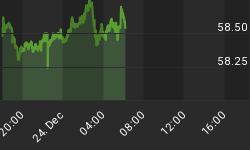One of the bull market axioms is that a rising tide will lift all boats. This means that a sign of an advancing bull market is that all issues and sectors will move higher. But when looking at the various SP500 sectors, I notice that all issues are not advancing, and in fact, it is only the defensive sectors that remain relative out performers.
Figure 1 is a weekly chart of the S&P Depository Receipt (symbol: SPY). The indicator in the lower panel seeks to measure the relative strength of the nine sector ETF's that make up the SP500 plus the SPY, itself. Those ETF's include: XLB (building materials), XLE (energy), XLF (financials) , XLI (industrials), XLK (technology), XLP (consumer durables), XLU (utilities), XLV (health care), and XLY (consumer discretionary). The relative strength indicator used to construct this composite has a 40 week look back. The indicator is in red, and a smoothed version is in black.
Figure 1. Relative Strength
Currently, the indicator value is at zero, which means that a rising tide is not lifting all boats. As it turns out, the positive sectors are the defensive sectors including: XLP, XLU, XLV, and XLY. XLK is just turning positive. Cyclically oriented sectors (XLB, XLE and XLI) are still negative. XLF and SPY continue to show negative relative strength.
As can be seen in the next graph, previous market bottoms (2003 and 2009) have been confirmed by a surge in buying across all sectors -- as in, a rising tide is lifting all boats.
Figure 2. Relative Strength
Lastly, if we change the relative strength look back from 40 weeks to 26 weeks, we still note (see figure 3) that all sectors are not being lifted by the current surge in prices as happened in 2003 (not shown on graph), 2009 and 2010.
Figure 3. Relative Strength
In summary, a rising tide is NOT lifting all boats, and the strongest sectors still continue to be the defensive sectors.















